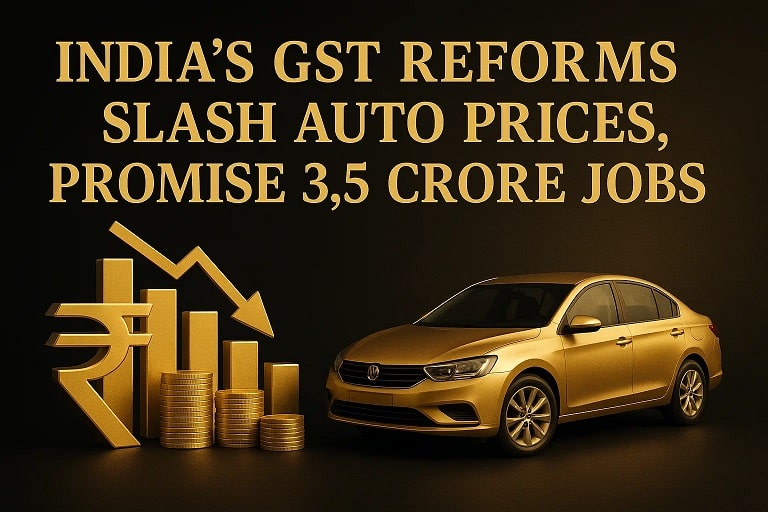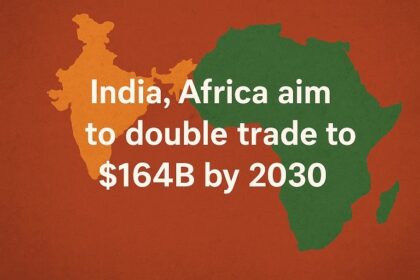India’s GST Reforms Slash Auto Prices, Promise 3.5 Crore Jobs: A Transformative Leap for the Economy
In a groundbreaking decision, India’s Goods and Services Tax (GST) Council has unveiled sweeping reforms for the automobile sector, slashing tax rates to make vehicles more affordable and projecting the creation of 3.5 crore (35 million) direct and indirect jobs. Announced on September 3, 2025, and effective from September 22, 2025, these reforms reduce GST rates on small cars, two-wheelers, and commercial vehicles from 28% to 18%, while luxury vehicles now face a streamlined 40% tax without additional cess. This bold move, aligned with Prime Minister Narendra Modi’s vision for a modernized economy, aims to boost consumer demand, empower small businesses, and cement India’s position as a global manufacturing hub. This in-depth article explores the details of the GST reforms, their immediate impacts, historical context, future prospects, and more, providing a complete guide to this transformative policy shift.
Why India’s GST Reforms Are a Game-Changer for the Auto Sector
The GST rationalization is a cornerstone of India’s broader economic strategy, complementing initiatives like Make in India, the Production Linked Incentive (PLI) scheme, and the National Logistics Policy. By lowering taxes on small cars and two-wheelers, the government seeks to make mobility accessible to both rural and urban consumers, driving sales during the festive season. The projection of 3.5 crore jobs reflects the reforms’ potential to stimulate the auto industry and its extensive supply chain, from component manufacturers to logistics providers. Additionally, the simplified tax structure—replacing complex cess-based systems with clear slabs—enhances transparency and boosts investor confidence, positioning India as a competitive player in global automotive markets.
Key Features of the GST Reforms
- Tax Reductions: GST on two-wheelers (up to 350cc), small cars (petrol <1200cc, diesel <1500cc, length <4m), and commercial vehicles like buses and trucks drops from 28% to 18%.
- Luxury Vehicles: Larger cars now face a flat 40% tax, eliminating additional cess for predictability.
- Job Creation: Expected to generate 3.5 crore jobs through increased production, supply chain expansion, and ancillary services.
- Export Push: Aims to enhance India’s global competitiveness in auto manufacturing, targeting markets in Africa, Southeast Asia, and Latin America.
Latest Developments and News
GST Council’s Historic Decision on September 3-4, 2025
At its 56th meeting in New Delhi, the GST Council finalized the tax cuts, with Finance Minister Nirmala Sitharaman announcing their implementation ahead of the Navratri festival on September 22, 2025. The decision followed Prime Minister Modi’s August 15, 2025, Independence Day speech, where he promised next-generation GST reforms to boost affordability and growth. The Auto Nifty index, tracking major auto stocks, surged nearly 11% since the announcement, reflecting strong market optimism about the sector’s revival.
Industry Leaders Celebrate on September 11, 2025
On September 11, 2025, the Ministry of Heavy Industries released a detailed report outlining the reforms’ benefits, including lower vehicle prices, job creation, and support for cleaner mobility solutions. Maruti Suzuki’s Managing Director and CEO, Hisashi Takeuchi, hailed the reforms as a “turning point” for India’s auto sector, predicting a significant demand surge during the festive season. Other industry leaders, including representatives from Hyundai, Tata Motors, and Bajaj Auto, echoed this sentiment, emphasizing the reforms’ role in making India a global automotive hub.
Immediate Price Reductions by Automakers
Following the announcement, major automakers swiftly reduced prices. Maruti Suzuki cut prices on models like the Swift and Baleno by up to 10%, while Hyundai slashed rates on the i20 and Venue. Two-wheeler giants like Hero MotoCorp and Bajaj Auto lowered prices on popular models like the Splendor and Pulsar, making them more accessible to budget-conscious buyers. Luxury brands such as Audi and BMW announced price cuts of ₹2.6-7.8 lakh on models like the Q8 SUV, reflecting the simplified 40% tax structure.
Market and Consumer Response
The stock market responded enthusiastically, with auto stocks like Maruti Suzuki, Tata Motors, and Mahindra & Mahindra gaining 3-7% on September 9-11, 2025. Consumer sentiment has also soared, with dealerships reporting a 20% increase in inquiries ahead of the festive season, signaling a potential sales boom.
Evolution of GST and India’s Auto Industry
India’s GST, launched in July 2017, unified the country’s fragmented tax system but initially imposed a high 28% rate plus cess (1-22%) on vehicles, making them costly for consumers. This led to periodic industry demands for tax rationalization, especially as auto sales stagnated post-COVID, with FY25 recording only 2% growth in passenger vehicle sales. Earlier reforms, such as the 2018 reduction of GST on auto components from 28% to 18%, improved supply chain efficiency and set a precedent for the 2025 overhaul. The auto sector, contributing 7% to India’s GDP and employing millions, has long been a focal point for economic reforms aimed at boosting manufacturing and exports.
Timeline of GST and Auto Sector Milestones
| Year | Event | Impact |
|---|---|---|
| 2017 | GST Implementation | Unified tax system but high 28% rate plus cess on autos. |
| 2018 | Auto Component GST Cut | Reduced from 28% to 18%, boosting supply chain growth. |
| August 2025 | PM Modi Announces GST Reform | Signals major tax overhaul for affordability. |
| September 2025 | GST Council Approves Cuts | 18% rate for small vehicles; 3.5 crore jobs projected. |
Historically, India’s auto industry has evolved from producing basic vehicles in the 1980s to becoming a global exporter, with companies like Maruti Suzuki and Tata Motors leading the charge. The 2025 reforms build on this legacy, aiming to make India a top automotive manufacturing hub, rivaling China and Japan.
Economic and Social Impacts of the GST Reforms
Consumer Benefits and Affordability
The reduction in GST rates translates to immediate price cuts of 5-10% on popular models like the Maruti Swift, Hyundai i20, Hero Splendor, and Bajaj Pulsar, making vehicles more affordable for first-time buyers and rural households. This is expected to drive a 15% sales surge during the 2025 festive season (Navratri to Diwali), boosting auto dealerships, financing firms, and related services like insurance. Lower prices also enhance accessibility to personal mobility, empowering middle-class and rural consumers.
Massive Job Creation
The reforms are projected to create 3.5 crore jobs, including 50 lakh direct jobs in manufacturing and 3 crore indirect jobs in supply chains (tyres, batteries, electronics), logistics, and retail. Micro, small, and medium enterprises (MSMEs), which form 60% of the auto supply chain, will see significant growth, particularly in tier-2 and tier-3 cities like Pune, Chennai, and Coimbatore. This job creation could reduce India’s urban unemployment rate, currently at 7.1%, and stimulate economic activity in rural areas.
Boost to Exports and Global Competitiveness
Lower production costs due to reduced taxes enhance India’s competitiveness in global markets, with auto exports projected to reach $50 billion by 2030. Companies like Tata Motors and Mahindra are ramping up electric vehicle (EV) exports, leveraging the unchanged 5% GST on EVs. This aligns with India’s ambition to capture a larger share of the $1 trillion global auto market, particularly in emerging economies like Africa and Southeast Asia.
Economic Growth and GDP Contribution
The reforms are expected to add 0.5% to India’s GDP in FY26, countering slowdown fears amid global trade tensions, such as recent US tariffs on Indian exports. The auto sector’s growth will also drive demand for steel, electronics, and logistics, creating a ripple effect across industries. By 2030, the sector could contribute $300 billion to India’s GDP, supporting the nation’s $5 trillion economy goal.
Challenges and Potential Risks
Despite the optimism, the reforms pose challenges, including an estimated ₹20,000 crore annual revenue loss for the government, which may strain fiscal budgets. Supply chain constraints, such as shortages of semiconductors and skilled labor, could hinder production ramps. Additionally, global trade barriers, like the US’s 50% tariffs on Indian goods, may limit export growth unless offset by new markets like Russia and China.
Future Scopes: Long-Term Vision for India’s Auto Sector
Sustained Growth and Global Leadership
By 2030, India’s auto industry could become the world’s third-largest, contributing $300 billion to GDP and rivaling China as a manufacturing hub. Maruti Suzuki plans to increase its production capacity by 500,000 units annually by 2027, while Hyundai and Tata Motors are investing in new plants to meet domestic and export demand. The reforms lay the foundation for India to capture 10% of global auto production by 2040.
Electric Vehicle (EV) Revolution
The unchanged 5% GST on EVs, combined with PLI incentives worth ₹25,000 crore, will accelerate India’s transition to cleaner mobility. By 2030, EVs are expected to account for 30% of vehicle sales, with companies like Tata Motors planning 10 new EV models by 2028. Investments in battery manufacturing and charging infrastructure will further bolster this shift, aligning with India’s net-zero emissions target by 2070.
Infrastructure and Policy Support
The government’s ₹1 lakh crore investment in auto-industrial parks, freight corridors, and logistics networks by 2030 will enhance supply chain efficiency. Continued GST simplification, potentially extending to other sectors like electronics and textiles, could drive broader economic growth. Labor law reforms and skill development programs will also ensure a ready workforce for the auto industry’s expansion.
Potential Scenarios for 2030
- Optimistic Outlook: Auto sector drives 20% of manufacturing GDP, creating 5 crore jobs and $50 billion in exports.
- Moderate Growth: Steady 10% annual growth with 3 crore jobs, tempered by global trade challenges.
- Pessimistic Scenario: Supply chain bottlenecks and trade barriers limit job creation to 2 crore, with exports at $30 billion.
Frequently Asked Questions (FAQs)
What are the new GST rates for vehicles in India?
Small cars (petrol <1200cc, diesel <1500cc, length <4m) and two-wheelers (up to 350cc) now face 18% GST, down from 28%. Larger cars are taxed at a flat 40%, and EVs remain at 5%.
How will the GST reforms create 3.5 crore jobs?
Increased vehicle demand will boost manufacturing, logistics, and MSME sectors like tyres, batteries, and electronics, creating direct and indirect jobs across the supply chain.
Which vehicles will see price reductions?
Popular models like Maruti Swift, Hyundai i20, Hero Splendor, and Bajaj Pulsar will be 5-10% cheaper, while luxury models like Audi Q8 will see cuts up to ₹7.8 lakh.
When do the GST reforms take effect?
The new rates are effective from September 22, 2025, aligning with the Navratri festival.
How will the reforms impact India’s economy?
They could add 0.5% to GDP in FY26, enhance exports, and empower MSMEs, though government revenue may dip by ₹20,000 crore annually.
What are the risks associated with these reforms?
Revenue losses, supply chain constraints, and global trade barriers could pose challenges, requiring robust policy and infrastructure support.
India’s Auto Sector Poised for a Golden Era
India’s GST reforms mark a transformative milestone, slashing auto prices and promising 3.5 crore jobs while positioning the nation as a global leader in automotive manufacturing. As the festive season approaches, these changes are set to ignite consumer demand, empower small businesses, and drive economic growth, heralding a new era for India’s auto industry and its role in the global economy.
Key Takeaways
- Affordable Mobility: GST cut to 18% makes small cars and bikes more accessible.
- Massive Job Creation: 3.5 crore jobs projected through manufacturing and supply chain growth.
- Export Surge: Lower costs enhance India’s global auto competitiveness.
- Sustainable Future: EV focus aligns with India’s clean energy goals.












